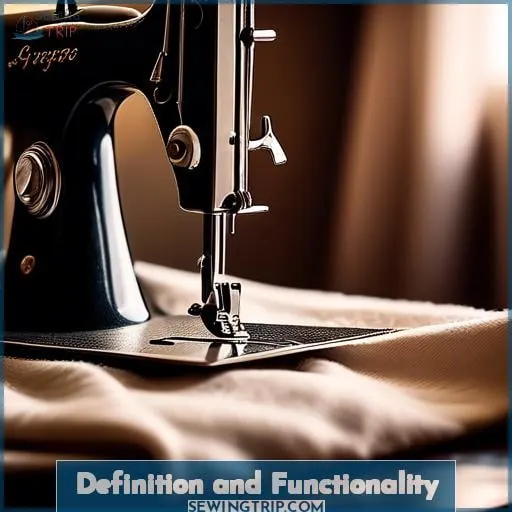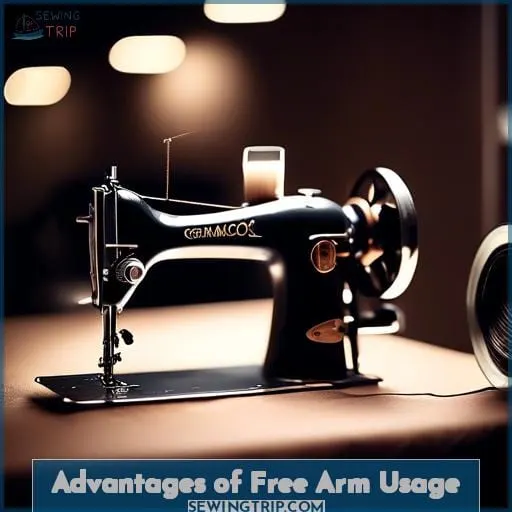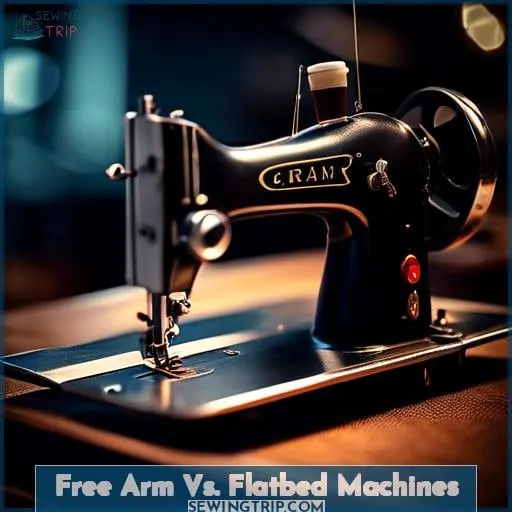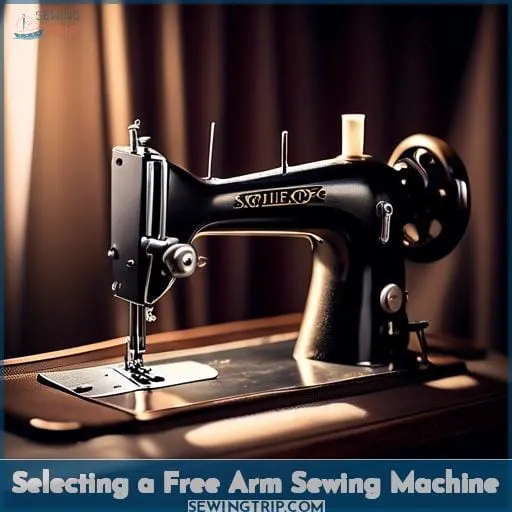This site is supported by our readers. We may earn a commission, at no cost to you, if you purchase through links.
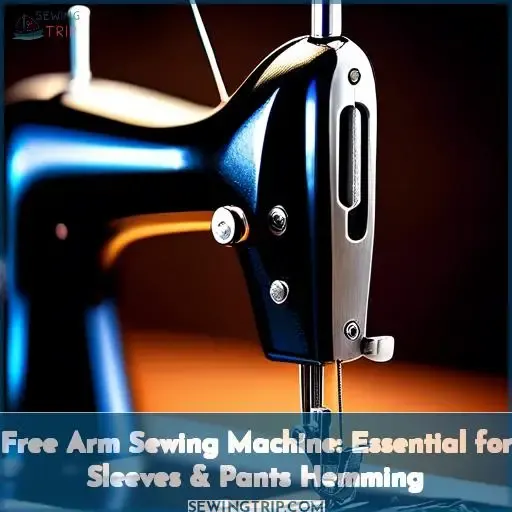
It is particularly useful when tackling sleeves and pants hems, preventing fabric bunching and simplifying complex tasks.
Whether you’re a seasoned tailor or a novice eager to master garment construction, understanding and utilizing a free arm sewing machine is key.
Table Of Contents
Key Takeaways
- Free arm sewing machines have a suspended bed, allowing fabric tubes like sleeves to be slid over the arm, simplifying sewing tasks such as hemming and attaching cuffs.
- These machines are compact and lightweight, making them travel-friendly and suitable for handling tubular pieces like sleeves and pant hems, with some models offering accessory storage for a user-friendly experience.
- The space beneath the free arm prevents fabric bunching and unintended stitching, especially beneficial for tasks like attaching sleeves and mending clothes, offering a more convenient sewing process for both tubular and round pieces.
- While free arm machines excel in sewing tubular pieces, flatbed machines are better suited for larger, flat fabrics. The choice between a free arm and a flatbed machine should be based on the specific requirements of the sewing project.
What is a Free Arm Sewing Machine
A free arm sewing machine features a suspended bed, allowing fabric tubes like sleeves to slide over it for easier sewing. This design is particularly helpful for hemming sleeves and pants, as well as sewing in round shapes.
Definition and Functionality
A free arm sewing machine features a narrow working surface with a space beneath it, which is particularly useful for sewing fabric tubes such as sleeves and pant legs. This design allows for easier handling of circular sewing tasks without bunching the fabric or accidentally stitching multiple layers together.
The free arm is beneficial for sewing tasks that involve tubular pieces of fabric, such as cuffs, hems, and sleeves. It prevents fabric from bunching up and reduces the risk of sewing unintended layers together, making the sewing process smoother and more precise.
While a free arm isn’t essential for all sewing projects, it’s ideal for specific tasks that involve sewing in the round. Flatbed machines provide more support for the fabric and a larger working surface, which is recommended for projects like quilting.
However, a free arm allows for the use of an extension table, which can be helpful for larger projects.
When choosing a free arm sewing machine, consider the diameter of the free arm, which determines the smallest size of the circle that can be sewn, and the length of the free arm, which affects how much fabric can be accommodated.
Most modern sewing machines come with a free arm, but vintage models may have narrower free arms suitable for smaller items.
Some recommended free arm sewing machine models include the Brother XR3774, which is versatile and suitable for a range of sewing and quilting projects, and the SINGER Heavy Duty 4432, which is designed for a variety of sewing tasks and features a strong motor for heavy-duty projects.
Narrow Working Surface
Dive into the world of free arm sewing machines, where the narrow working surface becomes your best ally.
- Compact Design: Perfect for travel-friendly sewing adventures, fitting snugly into your creative life.
- Accessory Storage: Keeps essentials at your fingertips, making the experience user-friendly.
- Lightweight: Effortlessly carry it to your next project, transforming hemming sleeves and sewing in the round into a breeze.
Space Beneath for Fabric Tubes
A free arm sewing machine is characterized by a narrow working surface with a space beneath it, allowing for the sewing of fabric tubes such as sleeves and pant legs. This feature is particularly beneficial for preventing fabric bunching and reducing the likelihood of accidentally stitching multiple layers together.
It simplifies tasks like attaching sleeves, sewing small items, and mending clothes.
However, a free arm isn’t essential for all sewing projects; for instance, flatbed machines are more suitable for quilting or sewing long straight seams due to their larger support surface. When choosing a free arm sewing machine, it’s important to consider the diameter of the free arm, which determines the smallest circle size that can be sewn, and the length of the free arm, which affects the amount of fabric that can be handled.
Most modern sewing machines come with a free arm, but vintage models may have narrower free arms, and some sergers or coverstitch machines also feature this option.
Advantages of Free Arm Usage
When you’re working on sewing projects that involve tubular pieces like sleeves or pant legs, a free arm sewing machine can be a game-changer. It’s designed with a narrow working surface and an open space beneath, allowing you to easily maneuver fabric tubes around the needle without bunching or accidentally sewing shut areas you don’t intend to.
This feature is particularly helpful for tasks such as hemming, attaching cuffs, and sewing smaller items where precision is key.
While a free arm isn’t an absolute necessity for sewing, it does offer distinct advantages. It simplifies the process of sewing in the round, reducing the likelihood of fabric shifting and the frustration of wobbly stitches.
For those who frequently work on garments, the convenience of a free arm can significantly streamline the sewing process.
However, it’s worth noting that free arm sewing machines aren’t the best choice for every task. For example, when quilting or working on large, flat pieces of fabric, a flatbed machine provides more support and a larger working surface, which is more conducive to those types of projects.
If you’re considering a free arm sewing machine, it’s important to assess the diameter and length of the free arm to ensure it meets your needs, especially if you’re working on smaller items or require a longer arm for certain projects.
In summary, a free arm sewing machine offers a specialized feature that can make sewing tubular pieces more efficient and less cumbersome. If your sewing projects include a lot of garment work, investing in a machine with a free arm could be a wise decision.
Prevents Fabric Bunching
When tackling the tricky task of sewing sleeve cuffs or adding a neat hem, a free arm sewing machine is your secret weapon. It reduces shifting and simplifies joining, ensuring your small item sewing is a breeze.
This specialized tool is perfect for round fabric shaping, turning a potential headache into a walk in the park. Say goodbye to fabric tangles and hello to precision with a free arm sewing machine.
Eases Sewing of Sleeves and Pant Legs
After tackling fabric bunching, let’s dive into the magic of free arm sewing machines for sleeves and pant legs.
Imagine hemming without the hassle—no more wobbly stitches on your tubular fabric. Whether it’s the snug fit of a sleeve or the flow of pant legs, the free arm’s design, considering tube diameter and length, makes sewing small items a breeze.
Free Arm Vs. Flatbed Machines
When comparing free arm and flatbed sewing machines, it’s important to recognize that each type has its own set of advantages for specific sewing tasks. While a flatbed provides a larger, more supportive workspace ideal for projects that require laying out fabric flat, such as quilting, a free arm is particularly useful for sewing tubular pieces like sleeves and pant legs.
The free arm feature allows for easier handling of these items, preventing fabric from bunching up and reducing the likelihood of accidentally sewing through multiple layers.
If you’re considering a sewing machine for tasks that involve sewing in the round, such as hemming sleeves or adding cuffs, a free arm machine can make these jobs less fiddly and more efficient. However, it’s not essential for all sewing projects, and many sewers successfully use flatbed machines for a wide range of tasks, including sewing tubular items by managing the fabric differently.
When not using the free arm, it’s best to reattach the flatbed to provide better fabric support and prevent shifting or wobbly stitches.
In summary, while a free arm isn’t a necessity, it can simplify certain sewing tasks. When choosing a sewing machine, consider the types of projects you’ll be undertaking most often to determine whether a free arm feature aligns with your sewing needs.
Flatbed Provides More Support
A free arm sewing machine is characterized by a narrow working surface with a space beneath it, allowing for the sewing of fabric tubes such as sleeves and pant legs. This feature is particularly useful for tasks that involve sewing in the round, as it prevents fabric bunching and reduces the likelihood of accidentally stitching multiple layers together.
The free arm provides less support than a flatbed, which offers a larger work area and is more suitable for projects that require more fabric support, such as quilting.
When considering a free arm sewing machine, it’s important to assess the diameter of the free arm, which determines the smallest circle size that can be sewn, and the length of the free arm, which affects the amount of fabric that can be accommodated.
Most modern sewing machines come with a free arm, but vintage models may have narrower free arms.
For those looking to purchase a free arm sewing machine, some recommended models include the Brother XR3774, SINGER Heavy Duty 4432, Brother ST371HD, Janome 2212, Janome Horizon Memory Craft 9850, SINGER ProFinish 14CG754, and the SINGER Tradition 2277 Sewing Machine.
Each of these models offers different features and benefits, so it’s important to choose one that fits your specific sewing needs and budget.
Free Arm Ideal for Specific Tasks
When you’re diving into sewing cuffs, hemming garments, or crafting sleeves, the free arm on your sewing machine becomes your best friend.
Unlike its flatbed cousin, which shines in quilting and long, straight seams, the free arm excels in small item creation and mending clothes.
It’s like having a nimble assistant, making those tricky, round parts not just doable but a breeze.
Selecting a Free Arm Sewing Machine
When considering a free arm sewing machine, it’s important to evaluate the diameter and length of the free arm itself. This will determine the smallest size of the fabric tube you can work with and the amount of fabric you can handle comfortably.
Most modern sewing machines come equipped with a free arm, but vintage models may offer narrower options, which could be beneficial for sewing smaller items like doll clothes. Sergers and coverstitch machines also sometimes feature free arms, expanding their versatility.
When selecting a machine, it’s also useful to look at models recommended for their free arm functionality, such as the Brother XR3774 and the SINGER Heavy Duty 4432, which are praised for their ease of use and versatility.
Consider Diameter and Length
Transitioning from the flatbed to the free arm debate, let’s zero in on the nitty-gritty of choosing your sewing ally.
- Diameter: Smaller diameters mean tackling those tricky sleeves with ease.
- Length: More length, more fabric; it’s a simple equation for your creative projects.
- Portability and Storage: With models like the SINGER Heavy Duty 4432, you’re looking at a blend of power and practicality without breaking the bank.
Assess Modern Versus Vintage Options
A free arm sewing machine is characterized by a narrow working surface with a space beneath, which is particularly useful for sewing fabric tubes such as sleeves and pant legs. The free arm is typically exposed on portable machines and can be accessed on larger machines by removing the flatbed attachment.
This design allows for greater flexibility when sewing circular or tubular pieces.
Free arm sewing machines are advantageous for a variety of tasks, including:
- Sewing in the round, such as sleeves and pant legs
- Hemming garments
- Attaching cuffs to shirts or blouses
- Sewing small and intricate items like doll clothes
- Mending areas that are difficult to access, like the knees of pants
When comparing free arm to flatbed sewing machines:
- A free arm isn’t essential for all sewing tasks but offers specific advantages for certain projects.
- Flatbed machines provide more support and a larger working surface, which is beneficial for projects like quilting.
- Free arm machines often allow for the attachment of an extension table, which can offer additional support when needed.
- It’s recommended to reattach the flatbed to the machine when the free arm functionality isn’t in use.
When selecting a free arm sewing machine, consider the following:
- The diameter of the free arm, which determines the smallest circle size you can sew.
- The length of the free arm, which affects the amount of fabric you can work with.
- Most modern sewing machines come equipped with free arms, but vintage models may have narrower free arms.
- Sergers and coverstitch machines may also feature free arms.
The free arm feature simplifies the process of sewing in the round, reducing fabric shifting and the likelihood of wobbly stitches. However, some items may be too small to fit around the free arm, which can limit its use for certain projects.
Recommended Free Arm Models
When considering a free arm sewing machine, the Brother XR3774 and SINGER Heavy Duty 4432 are notable options.
They both offer the specialized functionality needed for tasks like hemming sleeves and pants.
Brother XR3774
A free arm sewing machine is characterized by a narrow working surface with a space beneath, which allows for easier handling of fabric tubes such as sleeves and pant legs. This feature is particularly beneficial as it prevents fabric bunching and reduces the risk of accidentally stitching multiple layers together, simplifying tasks like sewing cuffs, hems, and small items.
While a free arm isn’t essential for all sewing projects, it offers distinct advantages for specific tasks. For example, it makes sewing in the round more efficient and can reduce fabric shifting and wobbly stitches.
However, for projects that require a larger working surface, such as quilting, a flatbed attachment is recommended for more support.
When choosing a free arm sewing machine, it’s important to consider the diameter of the free arm, which determines the smallest circle size you can sew, and the length, which affects the amount of fabric you can handle.
Most modern sewing machines come with a free arm, and some vintage models may feature narrower free arms.
The Brother XR3774 is an example of a sewing machine with a versatile free arm, offering 37 built-in stitches and an automatic needle threader for convenience. It also includes a jam-resistant bobbin and durable construction, making it suitable for a variety of sewing and quilting projects.
SINGER Heavy Duty 4432
Imagine powering through denim or canvas with ease; that’s the muscle of the SINGER Heavy Duty 4432’s heavy-duty motor.
Quick changes? Snap-on presser feet have got you covered.
Keep your sewing essentials at hand with onboard storage, and when you’re done, the soft-sided dust cover is your machine’s cozy blanket.
Plus, a limited warranty has your back—sew without a stitch of worry!
Frequently Asked Questions (FAQs)
How do I clean and maintain a free arm sewing machine?
To maintain your free arm sewing machine:
- Unplug it.
- Remove the needle and thread.
- Use a brush to clear lint from the bobbin case.
- Regularly oil as per the manual.
- Consider a professional service annually.
Can I upgrade my existing sewing machine to have a free arm?
Unfortunately, you can’t upgrade an existing sewing machine to have a free arm if it wasn’t designed with one.
About 90% of modern sewing machines come with a free arm, making it a common feature for new purchases rather than an upgrade option.
What are the common issues faced with free arm sewing machines?
Common issues with free arm sewing machines include broken or tangled threads. Skipped stitches, snapped needles, and inconsistent bobbin tension are also common problems. These issues can often be fixed by re-threading, adjusting tension, or changing needles without needing costly repairs.
How does fabric type affect sewing with a free arm machine?
When sewing with a free arm machine, fabric type is key.
Thicker fabrics may challenge your maneuverability, while lighter ones glide easily.
It’s all about matching the fabric’s dance to your machine’s rhythm.
Are there any specific techniques for sewing stretch fabrics with a free arm?
Imagine your sewing machine as a trusty steed, ready to gallop through the valleys of stretch fabrics without a hitch. When sewing stretch fabrics with a free arm, the golden rule is to let the fabric glide, not pull or push, as if dancing in harmony with the machine’s rhythm.
Use a ballpoint or stretch needle to waltz through the fabric without snagging. Opt for a polyester thread that stretches with the fabric, preventing the dreaded pop of a seam mid-cha-cha. A walking foot can be your dance partner, ensuring the fabric feeds evenly and keeps pace.
Conclusion
Imagine you’re hemming a pair of jeans for the first time. You’ve struggled with bunching fabric and uneven stitches, but then you discover the free arm sewing machine.
Suddenly, the task becomes simpler, and your stitches are even and professional-looking. This is the magic of a free arm sewing machine. It’s a game-changer for sewing sleeves, pant legs, and any tubular pieces.
By preventing fabric bunching and easing the sewing of complex parts, it’s an essential tool for both beginners and seasoned sewers. When comparing free arm to flatbed machines, remember that each has its place, but for specific tasks like hemming or adding cuffs, the free arm is unmatched.
If you’re in the market for one, consider the diameter and length of the free arm to ensure it meets your needs. Whether you opt for a modern machine like the Brother XR3774 or a heavy-duty option like the SINGER 4432, you’re investing in precision and ease for all your sewing projects.

